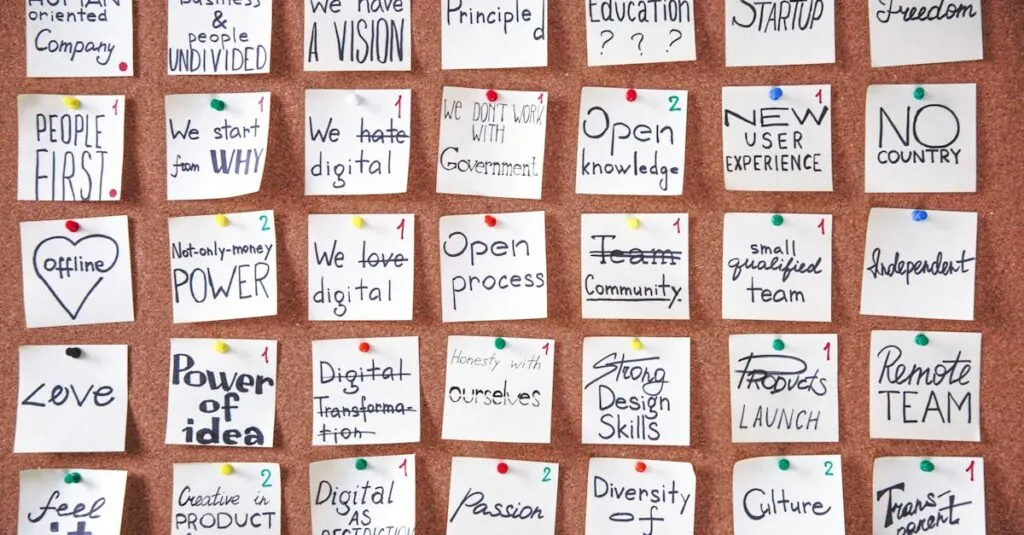In a world bursting with creativity, developing a design concept can feel like trying to find a unicorn in a haystack. But fear not! With the right approach, anyone can transform a spark of inspiration into a dazzling design. Whether you’re an aspiring designer or a seasoned pro looking to shake things up, mastering the art of concept development is your golden ticket to creating visuals that wow.
Table of Contents
ToggleUnderstanding Design Concepts
Understanding design concepts forms the foundation for creating impactful visual work. Designers must grasp the core ideas that drive their projects.
Definition of Design Concepts
Design concepts articulate the overarching theme or vision guiding a creative project. They encompass various elements such as color schemes, typography, and layouts. Each design concept serves as a blueprint, allowing designers to explore different styles and approaches. Effective design concepts streamline the decision-making process, ensuring alignment with project goals. A well-defined concept helps convey the intended message and resonates with the target audience.
Importance in the Design Process
Design concepts play a critical role in the entire design process. They establish a clear direction, minimizing confusion and disorganization. A solid design concept fosters creativity, encouraging designers to push boundaries while remaining focused. Collaboration among team members improves when a unified concept exists since it clarifies objectives. Ultimately, design concepts enhance the effectiveness of visual communication, delivering powerful messages to viewers.
Research and Inspiration
Research and inspiration play crucial roles in developing design concepts. They provide the foundation for creativity and innovation that guide effective visual communication.
Gathering Ideas
Collecting ideas requires an open mind. Engaging in brainstorming sessions often sparks creativity. Visiting art galleries, design museums, and online platforms like Behance or Dribbble showcases various styles and approaches. Observing daily life can inspire unique concepts; colors, shapes, and everyday objects often provide unexpected insights. Networking with other designers can yield valuable feedback and fresh perspectives. Maintaining an idea journal helps capture thoughts and visuals as they arise, ensuring an evolving pool of inspiration.
Analyzing Trends
Understanding current trends is essential for creating relevant designs. Analyzing industry reports and popular design publications reveals emerging styles and techniques. Social media platforms, especially Instagram and Pinterest, display trending aesthetics that resonate with audiences. Studying competitors offers insights into effective strategies while identifying market gaps. Design symposiums and conferences facilitate knowledge exchange and highlight innovative practices. Remaining informed about technological advancements can further enhance design capabilities, allowing for more dynamic, engaging outputs.
Brainstorming Techniques
Effective brainstorming techniques elevate the design concept development process. Various methods stimulate creativity and help capture ideas innovatively.
Mind Mapping
Mind mapping provides a visual way to organize thoughts. It begins with a central idea, then branches out into related concepts. Each branch can hold keywords, images, or themes, allowing designers to explore connections organically. Creating sub-branches encourages deeper exploration of each idea. Mind maps promote free thinking, making it easier to identify relationships between concepts. Tools like MindMeister or simple pen and paper can facilitate this method.
Sketching and Doodling
Sketching and doodling open channels for creative expression. Quick sketches can help visualize concepts without focusing on perfection. Doodling allows the mind to wander and explore different design elements. Designers often find that short, spontaneous illustrations lead to unexpected insights. This technique lowers the pressure of creating a finished product, fostering experimentation. Keeping a sketchbook handy can ensure that ideas are captured when they arise.
Refining Your Ideas
Refining ideas transforms initial concepts into robust designs. This process involves assessing feasibility and soliciting feedback.
Evaluating Feasibility
Assessing feasibility guides designers in understanding which concepts can realistically materialize. Start by evaluating resources such as time, budget, and materials. Identifying constraints helps prioritize ideas that align with project goals. Analyzing whether concepts meet functionality and user needs provides clarity for decision-making. Applying design thinking principles often leads to uncovering unexpected limitations or possibilities. Testing prototypes or small-scale executions allows designers to gauge practical application. When faced with multiple concepts, implementing a SWOT analysis helps clarify strengths, weaknesses, opportunities, and threats associated with each option.
Seeking Feedback
Feedback serves as a vital tool in the refinement stage of design concepts. Gathering insights from peers, mentors, or target audiences enhances the creative process. Creating a structured approach for presenting designs encourages focused discussions. Using open-ended questions elicits constructive criticism, fostering an environment of collaboration. Analyzing reactions can reveal areas for improvement, showcasing different perspectives on the design. Incorporating feedback loops ensures continuous iteration, making the final product more effective. Engaging in critique sessions or workshops helps solidify understanding and alignment with project objectives. Networking at design events also provides fresh viewpoints, enriching the overall outcome.
Prototyping and Testing
Prototyping and testing play crucial roles in transforming design concepts into tangible realities. These processes enable designers to explore ideas and gather feedback effectively.
Creating Low-Fidelity Prototypes
Creating low-fidelity prototypes allows designers to visualize concepts quickly. Sketches or wireframes represent initial ideas without the pressure of perfection. Rather than focusing on details, these prototypes emphasize functionality and layout. They also facilitate discussions with stakeholders, ensuring alignment early in the process. Designers can iterate designs based on feedback, refining their concepts before moving toward high-fidelity prototypes.
Importance of User Testing
User testing provides essential insights into how target audiences interact with designs. Gathering feedback from real users highlights strengths and weaknesses in usability. Effective user testing involves structured sessions where participants complete tasks using prototypes. Analyzing user behavior uncovers pain points, leading to targeted improvements. This process enhances overall design effectiveness, ensuring solutions meet user needs while aligning with project goals. Engaging users consistently throughout testing fosters a user-centered approach that enriches design iterations.
Developing compelling design concepts is an essential skill for any designer. By embracing research inspiration and effective brainstorming techniques, designers can unlock their creativity and generate innovative ideas. The refinement process further strengthens these concepts through feedback and prototyping, ensuring they meet both functionality and user needs.
Staying informed about trends and engaging with the design community can provide valuable insights that enhance one’s approach. Ultimately, mastering these elements not only leads to impressive designs but also fosters a deeper connection between the designer and their audience. With dedication and the right strategies, anyone can transform their creative visions into impactful realities.





